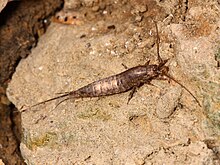Archaeognatha
| Archaeognatha Temporal range: Devonian–Recent |
|
|---|---|
 |
|
| Rock bristletail | |
| Scientific classification | |
| Kingdom: | Animalia |
| Phylum: | Arthropoda |
| Subphylum: | Hexapoda |
| Class: | Insecta |
| Subclass: |
Monocondylia Haeckel, 1866 |
| Order: |
Archaeognatha Börner, 1904 |
| Families | |
The Archaeognatha are an order of wingless insects, known by various common names such as jumping bristletails. Among extant insect taxa they are some of the most evolutionarily primitive; they appeared in the Middle Devonian period at about the same time as the arachnids. Specimens that closely resemble extant species have been found as both body and trace fossils (the latter including body imprints and trackways) in strata from the remainder of the Paleozoic Era and more recent periods.
For historical reasons an alternative name for the order is Microcoryphia
Until the late 20th century the suborders Zygentoma and Archaeognatha comprised the order Thysanura; both orders possess three-pronged tails comprising two lateral cerci and a medial epiproct or appendix dorsalis. Of the three organs, the appendix dorsalis is considerably longer than the two cerci; in this the Archaeognatha differ from the Zygentoma, in which the three organs are subequal in length. In the late 20th century, each of those two suborders was raised to the status of an independent order, since when the order Thysanoptera has been redundant and deprecated.
The order Archaeognatha is cosmopolitan; it includes roughly 350 species in two families. No species is currently evaluated as being at conservation risk.
Archaeognatha are small insects with elongated bodies and backs that are arched, especially over the thorax. They have three long tail-like structures, of which the lateral two are cerci, while the medial filament, which is longest, is an epiproct. The antennae are flexible. The two large compound eyes meet at the top of the head, and there are three ocelli. The mouthparts are partly retractable, with simple chewing mandibles and long maxillary palps.
...
Wikipedia
